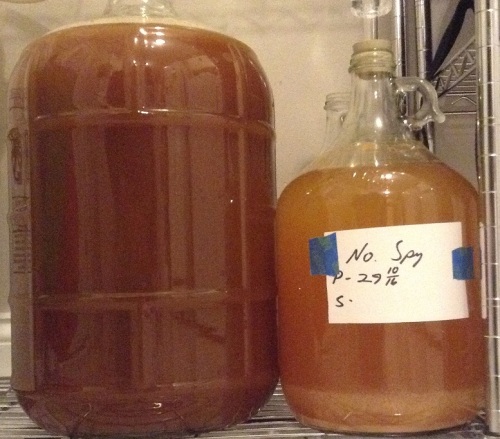Whenever I give someone a bottle of cyder, I ask them to let me know what they think, good, bad, or indifferent. I sincerely want to hear their reactions. Usually I get back the bland, overly-nice, “it was good,” or “I liked it.” If they didn’t like it I usually hear things like “it’s not my taste, but I’m sure it’s good,” or, if it was too sharp or sour for their taste they might say “something must have been wrong with the bottle.”(1)
I gave a bottle of cyder to a casual acquaintance. I expected he and his wife would try it and say something similar to the above. Instead they held an informal tasting with friends. They even made comment cards, which they shared with me when they returned the bottle.
As you can see the general consensus from their tasting is the cyder was somewhere from spicy to sour.
This is not an uncommon reaction to my cyders. Especially since I don’t arrest the fermentation to leave a residual sweetness or back sweeten. Most modern commercially-produced ciders are heavily back sweetened, which is what most people are used to.
But the charm of historical cider is that it’s generally what nature gives us and nature can be on the tart/sour side. At least that’s what my cidermaking experiments suggest. But what do historic sources say cider tasted like in the past?
Before looking at the records, it’s important to say people back then weren’t asking the same questions we are.(2) To them, cider tasted like cider. They didn’t see the need to parse flavors and there was no flavor wheel to consult.(3) They did refer to ciders as being too acidic or sweet. Common as they were, those are relative terms. For example, today what Americans think of as dry cider is not the same as what the Spanish think of as dry cider.(4)
What I’m looking for is a more direct explanation of cider. The earliest I’ve found is from Ephraim Chamber’s Cyclopædia, or, An universal dictionary of arts and sciences (1728), which defines cider as
…a brisk, tart, cool Liquor prepar’d from Apples.
The Cider Makers’ Manual (1869) says
When cider has been properly prepared in this manner, it will possess a pleasant acid, agreeable taste…
Zell’s Popular Encyclopedia, Vol. II (1883) described cider in less glowing terms, calling it
Acid; sour; harsh; rough; austere; as, hard cider…
Later, The Cider Makers’ Hand Book (1890) said cider
…should be tart, like Rhine wine, and by no means sharp or harsh. It should have a pleasant, fruity flavor, with aromatic and vinous blending, as if the fruit had been packed in flowers and spices. It should have mild pungency, and feel warming and grateful to the stomach, the glow diffusing itself gradually and agreeably throughout the whole system, and communicating itself to the spirits. It should have a light body or substance about like milk, with the same softness and smoothness, and it should leave in the mouth an abiding agreeable flavor of some considerable duration, as of rare fruits and flowers.(5)
It seems our pre-Prohibition ancestors enjoyed ciders which were significantly sharper, tarter, or sourer than most modern ciders.
************************************
- Occasionally comments are much more direct and contradictory. Recently, on social media, within moments of each other, one person said my cider was “undrinkable” and another said, “I love your cider!”
- For our purposes today “then” is anytime before Prohibition (1920).
- Some general flavor preferences are known but they’re usually extreme examples.For instance, one cider history stated that, “…Herefordshire labourers preferred cider so sour that it tasted like vinegar to strangers.” R.K. French, The History and Virtues of Cyder (New York: St.Martin’s Press, 1982), 17.
- There are many seventeenth-, eighteenth-, and nineteenth-century sources which compare cider to other alcoholic drinks, most commonly to Rhenish wine (think dry Riesling).
- Oh,to make cider like this!
AUTHOR’S NOTE: This post was updated on 25 February 2017.





